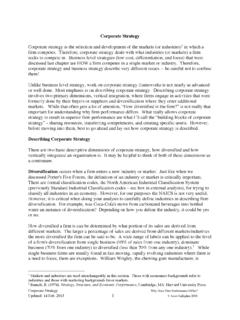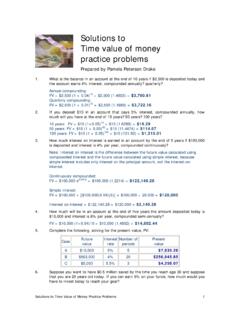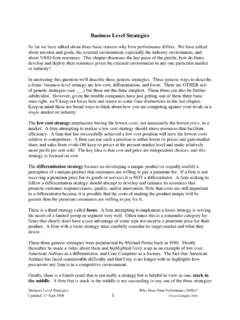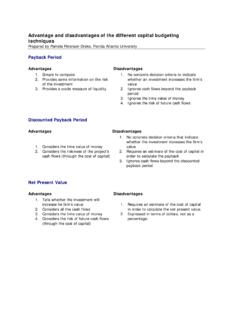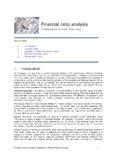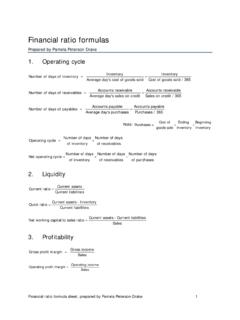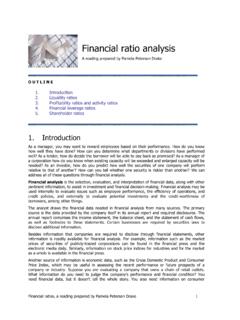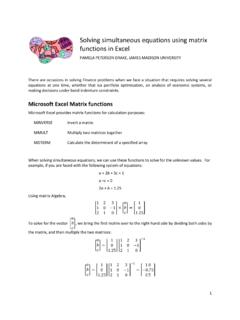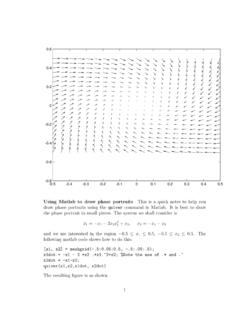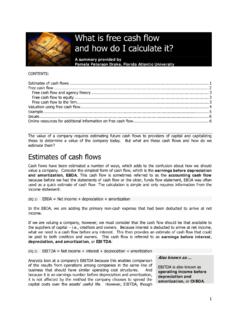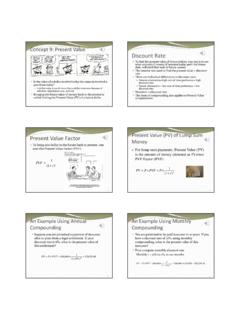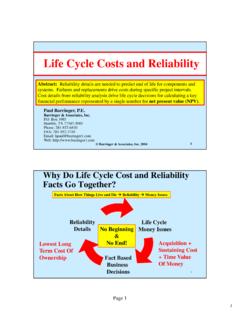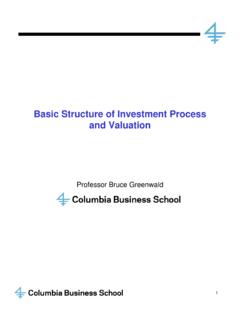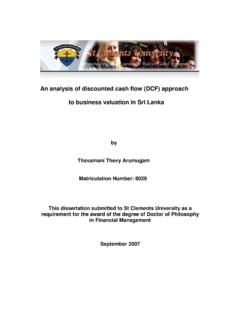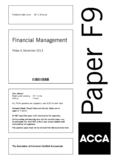Transcription of Residual income - educ.jmu.edu
1 1 Residual income A reading prepared by Pamela Peterson Drake James Madison University WHAT I S RESI DUAL I N COME? Analysts can choose from a number of methods to value a company s equity, including the discounted dividend and discounted free cash flow methods. Analysts have another option: the Residual income method. The analyst can use this method to value a company s equity by valuing the abnormal earnings of a company. Abnormal earnings in this context are the expected earnings of the company in excess of the cost of equity.
2 Using the Residual income method, I discount estimated future periods Residual income , or abnormal earnings. Residual income is defined as the amount by which earnings exceed the required rate of return on equity, in monetary terms. If a company has a book value of equity of $1 billion and a required rate of return on equity of 8 percent, the company has Residual income when earnings exceed $1 billion x 8 percent = $80 million. Residual income , in theory, may continue indefinitely or follow a pattern much like that of dividends or free cash flows, such as constant growth, two-stage, H-model, and so on.
3 However, the basic reasoning of the Residual income model is that value is created when earnings exceed the required rate of return on equity; that is, when there is economic profit. Economic profit is the profit generated in excess of the cost of equity, which is derived from the company s comparative or competitive advantage. Based on economic theory, the competitive or comparative advantage and hence the economic profit -- is expected to fade through Therefore, in most cases analysts use the Residual income method assuming the erosion of abnormal earnings through time.
4 T HE N EC ESSARY I N PUTS The use of the Residual income method requires information on the book value of equity, forecasted return on equity (ROE), the retention rate, and the cost of equity. The return on equity is the anticipated first period return. Along with this estimate, the analyst must estimate how long it takes for the economic profit to reach zero; in other words, how long does it take for the return on equity to reach the cost of equity. The analyst must estimate how long the abnormal returns will last, and this length is used to determine the rate at which the ROE declines to the cost of equity.
5 For example, if the return on equity is 15% and the cost of equity is 10%, and the analyst believes the company will have its comparative advantage for three years, with the advantage eroding linearly, the return on equity for the first three years is 15%, , and , with the ROE equal to the cost of equity of 10% in the fourth year and thereafter. FOREC ASTING RESI DUAL IN C OME Suppose the analyst is forecasting for the Sample Company and has gathered the inputs that I show in Exhibit 1. The analyst forecasts Residual income based on the anticipated ROE and retention rate.
6 For example, the earnings for FY1 are 15% x $10 = $ , and the dividends are 30% of $ , or $ Therefore the ending book value of equity per share is $10 + ($ ) = $ The abnormal earnings are the difference between the earnings of $ and the cost of equity on a monetary basis. the cost of equity in monetary terms is the cost of equity multiplied by the beginning book value of equity, or 10% x $10 = $1. Therefore, the abnormal earnings in this period are $ = $ 1 A comparative advantage is the ability to produce a good or deliver a service at a lower opportunity cost relative to others.
7 A competitive advantage is the advantage that a company has over other businesses that arises from either a cost advantage ( , from economies of scale) or product differentiation. 2 The analyst forecasting Residual income for future periods repeats these calculations for each period in which there are abnormal earnings. The analyst then discounts these abnormal earnings to the present and then adds these to the book value of equity per share to determine the value of equity. You should note that when the return on equity is equal to the cost of equity, the abnormal earnings are zero and there is nothing to discount; therefore, in our example there would be nothing to discount beyond three years from the present.
8 I show the calculation of abnormal earnings in Exhibit 2. VALUAT I ON Valuing Residual income requires repeating this calculation for all years up to the point at which the Residual income is zero; that is, until the return on equity is equal to the required rate of return on equity capital. After the analyst calculates the Residual income for each year in the future, he/she discounts this income to the present at the required rate of return on equity and then add this to the beginning book value of equity. The sum of the present value of the Residual income and the beginning book value of equity is the estimate of the value of equity.
9 I present the detailed calculations of the abnormal earnings in Exhibit 2, and the calculation of the value of equity per shares in Exhibit 3. To execute a Residual income calculation, the analyst must estimate the path by which return on equity declines until it reaches the required rate of return on equity. Assume that the return on equity declines until it is equal to the required rate of return on equity after three years; in other words, by FY4 the return on equity is equal to the cost of equity. Assuming a cost of capital of 10% percent, the present value of the Residual income , discounted at the required rate of return on equity of 10% percent, is $ per share.
10 Adding this present value to the beginning book value of equity per share of $10 per share results in a value of $ per share. The value of equity using the Residual income model is affected not only by the required rate of return on equity, but by the assumption of the decline in equity and hence the anticipated return on equity. If the analyst varies the assumptions slightly, he/she arrives at different valuations. For example, if the ROE reaches the cost of equity after five years, the value per share would be $ I show the calculations for this assumption in Exhibit 4.
